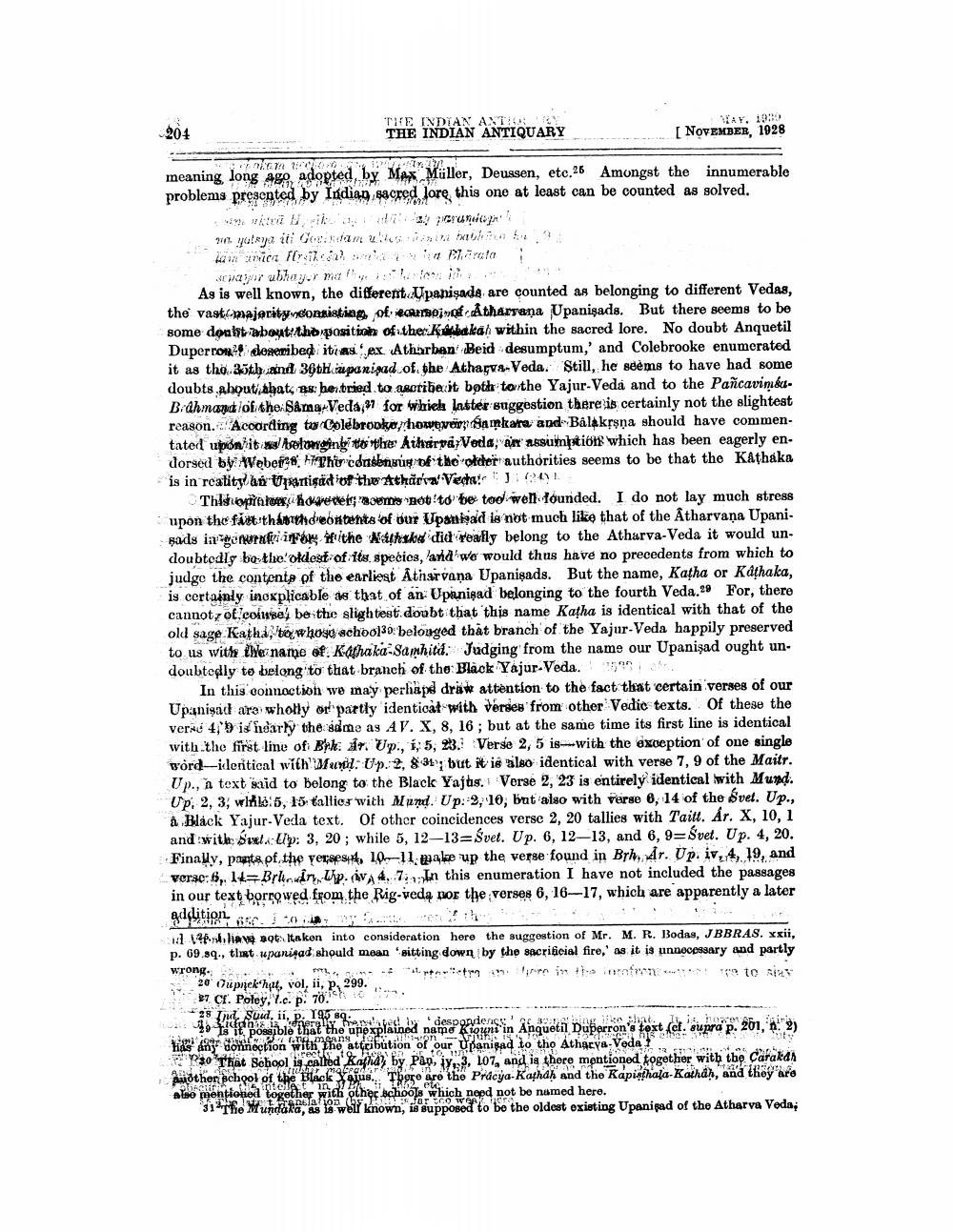________________
THE INDIAN ANTA THE INDIAN ANTIQUARY
...
NOVEMBER, 1928
meaning long ago adopted by Max Müller, Deussen, etc.26 Amongst the innumerable problems presented by India sacred lore this one at least can be counted as solved.
90 yatrya iti Goran u tinin Ohh Laan met fria
fralai C hor ubhay. m
. As is well known, the different. Upanişads are counted as belonging to different Vedas, the vast majority consisting of carboina Atharyana Upanişads. But there seems to be some denkt about the position of the Kibakah within the sacred lore. No doubt Anquetil Duperron doseribed ittas ex Atharban' Beid desumptum,' and Colebrooke enumerated it as tho 35th and 30th parimad of the Athagva-Veda. Still, he seems to have had some doubts about that, as he tried to ascribe it both to the Yajur Veda and to the Pancavimu. Bidhmand of the Sama Veda, 37 for which laster suggestion there is certainly not the slightest reason. According tw Colebrook however Samkara and Balakrsna should have commentated upon its belonging to the Atharva Veda, Art assumtiof which has been eagerly en. dorsed by: AVeberze phù consensus of the other authorities seems to be that the Kathaka is in reatity an artişádiot the Atharva Vedas":
This into hoberet Bombotito be too well founded. I do not lay much stress upon the faithátthreontants of our Upenisad is not much like that of the Atharvana Upani. kads in our fór hithe Withslow did really belong to the Atharva-Veda it would un. doubtedly be the oldest of its species, and we would thus have no precedents from which to judge the contents of the earliest Atharvana Upanişads. But the name, Katha or Kathaka, is certainly inexplicable 18 that of an Upanişad belonging to the fourth Veda.29 For, there cannot 7 of colupe'be the slightest doubt that this name Katha is identical with that of the old sage Katha, 'boy, whos achbo]30 belonged that branch of the Yajur Veda happily preserved to us with the name of Kathaka Samhita. Judging from the name our Upanişad ought un. doubtedly to belong to that branch of the Black Yajur Veda. 15
In this connection we may perhaped draw attention to the fact that certain verses of our Upanised are wholly or partly identicat with verses from other Vedic texts. Of these the vernd 4,9 is nearly the sdme as AV. X, 8, 16; but at the same time its first line is identical with the first line of Bhkr. Up., 1, 5, 23. Verse 2, 5 is with the exception of one single word-iderítical with Mund. Up. 2, 8-34); but it is also identical with verse 7, 9 of the Maitr. Up., a text said to belong to the Black Yajus. Verse 2, 23 is entirely identical with Mund. Up, 2, 3, wille 5, 15 tallios with Mund. Up: 2, 10, but also with Verse 6, 14 of the Svel. Up., å Black Yajur Veda text. Of other coincidences verse 2, 20 tallies with Taitl. Ar. X, 10, 1 and with SulUp: 3, 20; while 5, 12-13=Svet. Up. 6, 12-13, and 6, 9=Svet. Up. 4, 20. Finally, pants pf the yerses, 10-11 wake up the verse found in Brh, Ar. Up. iv, 4, 19, and verse:6, 1=Brlenir Up (AVA 4,7. In this enumeration I have not included the passages in our text borrowed from the Rig-vedą nor the verses 6, 16-17, which are apparently a later
12 . have agt. Itaken into consideration here the suggestion of Mr. M. R. Bodas, JBBRAS. xxii, p. 69.sq., tlit upanijad should mean sitting down by the sacrificial fire,' as it is unnecessary and partly
...
20 upek'hut, vol, ii, P. 299. B7 Cr. Poley, Y.c. p. 70.
28 Thu Suid. ii. D. 1960.. wat oo r
despozydens 2.A klase Hast days donnection with the atquibution of "our Upanised to tho Atharya Voda".
PsoʻThat School is called afhay by Pap, i3, 107, and is there mentioned together with the Carakah Auðther pch pol of the Black jus. The aro the Pracya-Kathah and tho Rapinthaja-Kathaḥ, and thöy are albo mautions together with other school. Which need not be named here.
2. Wundana, a wy known, upposed to be the oldest existing Upanipad of the Atharva Voda




